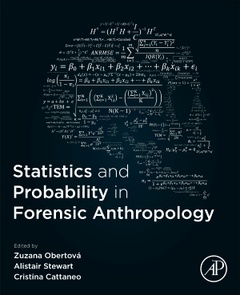Statistics and Probability in Forensic Anthropology
Coordonnateurs : Obertová Zuzana, Stewart Alistair, Cattaneo Cristina

Statistics and Probability in Forensic Anthropology provides a practical guide for forensic scientists, primarily anthropologists and pathologists, on how to design studies, how to choose and apply statistical approaches, and how to interpret statistical outcomes in the forensic practice. As with other forensic, medical and biological disciplines, statistics have become increasingly important in forensic anthropology and legal medicine, but there is not a single book, which specifically addresses the needs of forensic anthropologists in relation to the research undertaken in the field and the interpretation of research outcomes and case findings within the setting of legal proceedings.
The book includes the application of both frequentist and Bayesian statistics in relation to topics relevant for the research and the interpretation of findings in forensic anthropology, as well as general chapters on study design and statistical approaches addressing measurement errors and reliability. Scientific terminology understandable to students and advanced practitioners of forensic anthropology, pathology and related disciplines is used throughout. Additionally, Statistics and Probability in Forensic Anthropology facilitates sufficient understanding of the statistical procedures and data interpretation based on statistical outcomes and models, which helps the reader confidently present their work within the forensic context, either in the form of case reports for legal purposes or as research publications for the scientific community.
2. General Considerations About Method Selection
3. Frequentists and Bayesian Approach to Data Analysis and Interpretation
4. Variables of the Biological Profile: Population Studies and Application to Single Cases
5. Personal Identification
6. Evaluation of Evidence and Reporting
7. Statistical Programs
Cristina Cattaneo - forensic pathologist and anthropologist, is currently Full Professor of Legal Medicine at the Faculty of Medicine of the Università degli Studi di Milano (Italy) and Director of LABANOF, Laboratorio di Antropologia e Odontologia Forense. She has been actively involved with the Italian Ministry of Internal Affairs in the creation of a national database for unidentified human remains and has since 2014 been the medico legal coordinator for the Governmental Office of the Commissioner for Missing Persons for the identification of dead migrants. She also coordinates the medico legal activities on victims of maltreatment, torture and on unaccompanied minors in Milano. She is a forensic pathology and anthropology expert for various courts in Italy and occasionally in Europe, President of FASE (Forensic Anthropology Society of Europe), memb
- Contains the application of both frequentist and Bayesian statistics in relation to topics relevant for forensic anthropology research and the interpretation of findings
- Provides examples of study designs and their statistical solutions, partly following the layout of scientific manuscripts on common topics in the field
- Includes scientific terminology understandable to students and advanced practitioners of forensic anthropology, legal medicine and related disciplines
Date de parution : 07-2020
Ouvrage de 418 p.
19x23.3 cm
Thèmes de Statistics and Probability in Forensic Anthropology :
Mots-clés :
Accuracy; Age at death; Age-at-death estimation; Anatomical methods; Ancestry; Artificial neural network; Asymmetry; Bayes; Bayes’ theorem; Bayesian age estimation; Bayesian analysis; Bayesian statistics; Bias; Biogeographic origins; Biological data; Biological profile; Body parameters; Canonical variate analysis; Cohen’s Kappa; Comparative analysis on images; Conformal prediction; Contextual bias; Criminalistics; Cross validation; Data mining; Data preparation; Data step; Decision trees; Discriminant analysis; Discriminant function; DNA; Documented skeletal repositories; Errors of reasoning; Estimation; Evaluative; Extreme learning machine; Facial features; Facial recognition; Fordisc; Forensic anthropology; Forensic medicine; Forensic science; Frequentist inference; Frequentist statistics; Functions; Geometric morphometrics; Graphics; Identification; Interpreting evidence; Interrater error; Intrarater error; Investigative; Judiciary; Least squares; Likelihood ratio; Linear regression; Machine learning; Measurement error; Medicolegal contexts; Morphological analysis; Multidetector computed tomography; Multivariate regression; Nonparametric tests; Normal distribution; Observational error; Observational study; Odontology; Ordinal scale; Parametric tests; Partial least squares analysis; Population data; Population specificity; Principal component analysis; Procedures; Procrustes superimposition; Propositions; R; Random forests; Random sample; Regression analysis; Regression methods; Reliability; Reporting; Sample size; Scientific computing; Sensitivity; Sex; Sex diagnosis; Sex estimation; Shape; Specificity; SPSS; Statistical analysis; Statistical software; Statistics analysis; Stature; Stature estimation; Strength of evidence; TEM; Validity; Virtual anthropology; Visual identification; Web-based applications



